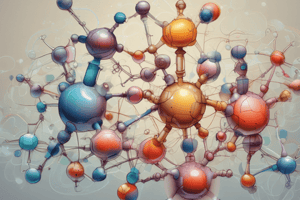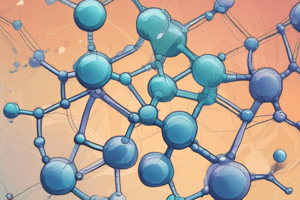Podcast
Questions and Answers
What is the correct IUPAC name for N-ethyl-N-methyl-1-propanamine?
What is the correct IUPAC name for N-ethyl-N-methyl-1-propanamine?
- N-ethyl-2-methylpropanamine
- 3-pentanamine
- N-methyl-N-ethylpropan-1-amine (correct)
- N-ethyl-1-methylpropanamine
Which of the following represents a characteristic of heterocyclic compounds?
Which of the following represents a characteristic of heterocyclic compounds?
- They cannot contain any nitrogen atoms.
- They only contain carbon atoms.
- They can include multiple types of atoms in the ring. (correct)
- They are exclusively found in synthetic compounds.
Which compound is considered the most important aromatic amine?
Which compound is considered the most important aromatic amine?
- Aniline (correct)
- N-methylaniline
- Cyclohexylamine
- Ethylamine
How are derivatives of aniline named?
How are derivatives of aniline named?
Which of the following correctly describes a property of urea?
Which of the following correctly describes a property of urea?
Which of the following describes the nomenclature used when substituting a hydrogen in an aromatic compound?
Which of the following describes the nomenclature used when substituting a hydrogen in an aromatic compound?
What is one common heteroatom found in nitrogen-based heterocyclic compounds?
What is one common heteroatom found in nitrogen-based heterocyclic compounds?
Which of these amines is classified as a heterocyclic amine?
Which of these amines is classified as a heterocyclic amine?
What is the correct suffix used when naming amines following IUPAC rules?
What is the correct suffix used when naming amines following IUPAC rules?
In primary amines, how is the longest continuous carbon chain identified?
In primary amines, how is the longest continuous carbon chain identified?
Which of the following statements is true regarding the nomenclature of secondary and tertiary amines?
Which of the following statements is true regarding the nomenclature of secondary and tertiary amines?
What happens to the naming of diamines according to IUPAC rules?
What happens to the naming of diamines according to IUPAC rules?
Which of the following best describes the common naming convention for aliphatic amines?
Which of the following best describes the common naming convention for aliphatic amines?
What is the purpose of dropping the -e from the corresponding alkane when naming an amine?
What is the purpose of dropping the -e from the corresponding alkane when naming an amine?
What type of amine is characterized by having two alkyl groups attached to the nitrogen?
What type of amine is characterized by having two alkyl groups attached to the nitrogen?
Which of the following is NOT a step in naming an amine according to IUPAC conventions?
Which of the following is NOT a step in naming an amine according to IUPAC conventions?
Which statement accurately describes the classification of amines?
Which statement accurately describes the classification of amines?
What is the significance of the strong odors associated with amines?
What is the significance of the strong odors associated with amines?
Which of the following methods is NOT used in the preparation of amines?
Which of the following methods is NOT used in the preparation of amines?
What type of amine results from the alkylation of ammonia in a successive reaction?
What type of amine results from the alkylation of ammonia in a successive reaction?
Which reduction process is specifically used to convert amides into amines?
Which reduction process is specifically used to convert amides into amines?
Which amine odor is typically described as 'fishy'?
Which amine odor is typically described as 'fishy'?
All of the following statements about amines are true EXCEPT?
All of the following statements about amines are true EXCEPT?
Which characteristic of aliphatic amines is notable in relation to their physical properties?
Which characteristic of aliphatic amines is notable in relation to their physical properties?
Flashcards
IUPAC naming of amines
IUPAC naming of amines
A systematic method for naming amines using the longest carbon chain containing the amine group and adding the suffix -amine.
Primary amine
Primary amine
An amine where the nitrogen atom is bonded to one carbon.
Secondary amine
Secondary amine
An amine where the nitrogen atom is bonded to two carbons.
Tertiary amine
Tertiary amine
Signup and view all the flashcards
Alkane to Amine naming
Alkane to Amine naming
Signup and view all the flashcards
Common amine names
Common amine names
Signup and view all the flashcards
Diamines
Diamines
Signup and view all the flashcards
Capital N prefix
Capital N prefix
Signup and view all the flashcards
Heterocyclic Compounds
Heterocyclic Compounds
Signup and view all the flashcards
Heteroatoms
Heteroatoms
Signup and view all the flashcards
Nitrogen-based Heterocyclic Compounds
Nitrogen-based Heterocyclic Compounds
Signup and view all the flashcards
Aromatic Amines
Aromatic Amines
Signup and view all the flashcards
Anilines
Anilines
Signup and view all the flashcards
Ring Substituted Anilines
Ring Substituted Anilines
Signup and view all the flashcards
IUPAC Name
IUPAC Name
Signup and view all the flashcards
Common Name
Common Name
Signup and view all the flashcards
Amines and Hydrogen Bonding
Amines and Hydrogen Bonding
Signup and view all the flashcards
Solubility of Aliphatic Amines
Solubility of Aliphatic Amines
Signup and view all the flashcards
Odor of Amines
Odor of Amines
Signup and view all the flashcards
Alkylation of Ammonia
Alkylation of Ammonia
Signup and view all the flashcards
Quaternary Ammonium Salt
Quaternary Ammonium Salt
Signup and view all the flashcards
Reduction of Amides to Amines
Reduction of Amides to Amines
Signup and view all the flashcards
Reduction of Nitriles
Reduction of Nitriles
Signup and view all the flashcards
Reduction of Aromatic Nitro Compounds
Reduction of Aromatic Nitro Compounds
Signup and view all the flashcards
Study Notes
Amides and Amines: Organic Nitrogen Compounds
- Nylon is a material used to make colorful sails due to its strength and durability
- Amides are neutral nitrogen-containing compounds
- They are neither acidic nor basic, existing as molecules in both aqueous solutions and pure form
- Amides contain carbonyl groups directly connected to a nitrogen atom
- Amides are prepared from carboxylic acids and ammonia through heating.
Amides: Nomenclature and Physical Properties
- Amides are formed when a carboxylic acid is heated in the presence of ammonia
- This process produces an ammonium salt as an intermediate
- This intermediate is further heated forming the amide and water
- Ammonium salts of carboxylic acids can also be converted to amides by heating
IUPAC Rules for Naming Amides
- The longest continuous carbon chain containing the amide group is used as the base name
- The carbonyl carbon is labeled as the #1 carbon atom
- The -oic acid suffix is dropped from the corresponding carboxylic acid and replaced with -amide
IUPAC names for amides
- IUPAC names for amides are derived from the corresponding carboxylic acid
- The -oic acid ending is replaced with -amide
- Examples include methanamide (from methanoic acid) and ethanamide (from ethanoic acid)
Additional Naming Rules for Amides
- A capital 'N' (italicized) is used as a prefix if alkyl groups or other substituents are attached directly to the amide nitrogen atom
- Examples include N-methylacetamide and N,N-diethylpropionamide
Common Names for Amides
- Common names for amides are derived from the common names of the corresponding carboxylic acids
- Examples include formamide from formic acid and butyramide from butyric acid
Physical Properties of Amides
- Amides exhibit high water solubility and high melting/boiling points, primarily due to strong intermolecular hydrogen bonding
- Low molar mass amides are soluble in water
Chemical Properties of Amides
- A crucial reaction of amides is hydrolysis, which involves breaking the amide bond using either acid or base
- Acidic hydrolysis produces a carboxylic acid and an ammonium salt
- Basic hydrolysis produces a carboxylate salt and ammonia
Polyamides: Condensation Polymers
- Polyamides are polymers containing repeating amide linkages
- Polyamides can be synthetic, like Nylon-66, or biological, such as the protein chymotrypsin
- Nylon-66 has a specific repeating structural unit
Urea
- Urea is a diamide that's naturally excreted as a nitrogenous waste product
- It's a white solid, soluble in water, and melts at 133°C
- Urea is used as a fertilizer and in plastic/barbiturate production
Classification of Amines
- Amines are nitrogen-containing organic compounds that are classified based on the number of hydrocarbon groups attached to the nitrogen atom
- These include primary, secondary, and tertiary amines
Examples of Primary, Secondary, and Tertiary Amines
- Examples of primary amines include methylamine and aniline
- Examples of secondary amines include methylaminoethane and diethylamine
- Examples of tertiary amines include triethylamine
IUPAC Rules for Naming Amines
- The longest continuous carbon chain containing the amine group is used as the base name for the amines
- The carbon atom connected to the amine group is the #1 carbon
- The suffix -e of the corresponding alkane is dropped and replaced by -amine
Naming Aliphatic Amine Derivatives
- Common names for aliphatic amines are formed by naming alkyl groups or substituents followed by the suffix -amine
- Examples such as ethylamine, propylamine, isopropyl amine, tert-butylamine, and ethyldimethylamine are found
Naming Aromatic Amines
- Aromatic amines are primarily identified by their common name, aniline (C₆H₅NH₂)
- Amine derivatives use the substituted aniline naming convention
Physical Properties of Amines
- Amines are capable of hydrogen bonding with water, which contributes to their water solubility, this is most apparent in lower-molecular-weight amines
- Flammable gases, with varying odors, can occur in primary amines.
Preparation of Amines
- Amines can be prepared through various processes
- Alkylation of ammonia, Reduction of amides, Reduction of nitriles, and Reduction of aromatic nitro compounds
Chemical Properties of Amines
- Amines exhibit alkaline properties, acting as weak bases in water, producing hydroxide ions; some are flammable gases
- A reaction of amines with strong acids forms ammonium salts
- Amides are formed through the reaction of amines with acid chlorides
Sources and Uses of Selected Amines
- Various amines are found in biological systems
- Biogenic amines often function as neurotransmitters and hormones
- Some amines are components of widely-used stimulants or medications
- Other amines are components of various products, and some can be noxious
Studying That Suits You
Use AI to generate personalized quizzes and flashcards to suit your learning preferences.




